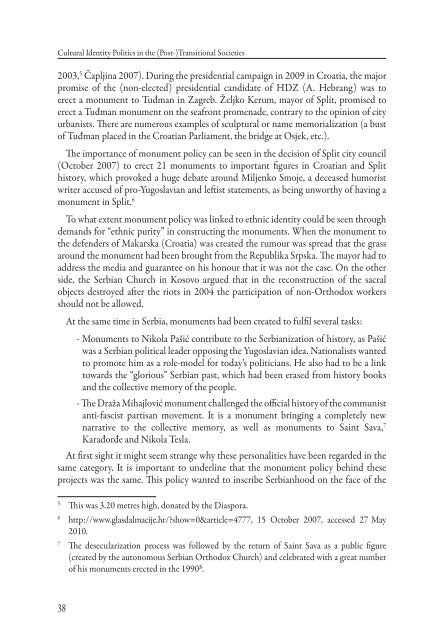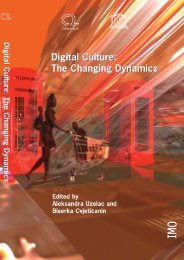free download in pdf format - Culturelink Network
free download in pdf format - Culturelink Network
free download in pdf format - Culturelink Network
You also want an ePaper? Increase the reach of your titles
YUMPU automatically turns print PDFs into web optimized ePapers that Google loves.
Cultural Identity Politics <strong>in</strong> the (Post-)Transitional Societies<br />
2003, 5 Čaplj<strong>in</strong>a 2007). Dur<strong>in</strong>g the presidential campaign <strong>in</strong> 2009 <strong>in</strong> Croatia, the major<br />
promise of the (non-elected) presidential candidate of HDZ (A. Hebrang) was to<br />
erect a monument to Tuđman <strong>in</strong> Zagreb. Željko Kerum, mayor of Split, promised to<br />
erect a Tuđman monument on the seafront promenade, contrary to the op<strong>in</strong>ion of city<br />
urbanists. Th ere are numerous examples of sculptural or name memorialization (a bust<br />
of Tuđman placed <strong>in</strong> the Croatian Parliament, the bridge at Osjek, etc.).<br />
Th e importance of monument policy can be seen <strong>in</strong> the decision of Split city council<br />
(October 2007) to erect 21 monuments to important fi gures <strong>in</strong> Croatian and Split<br />
history, which provoked a huge debate around Miljenko Smoje, a deceased humorist<br />
writer accused of pro-Yugoslavian and left ist statements, as be<strong>in</strong>g unworthy of hav<strong>in</strong>g a<br />
monument <strong>in</strong> Split. 6<br />
To what extent monument policy was l<strong>in</strong>ked to ethnic identity could be seen through<br />
demands for “ethnic purity” <strong>in</strong> construct<strong>in</strong>g the monuments. When the monument to<br />
the defenders of Makarska (Croatia) was created the rumour was spread that the grass<br />
around the monument had been brought from the Republika Srpska. Th e mayor had to<br />
address the media and guarantee on his honour that it was not the case. On the other<br />
side, the Serbian Church <strong>in</strong> Kosovo argued that <strong>in</strong> the reconstruction of the sacral<br />
objects destroyed aft er the riots <strong>in</strong> 2004 the participation of non-Orthodox workers<br />
should not be allowed.<br />
At the same time <strong>in</strong> Serbia, monuments had been created to fulfi l several tasks:<br />
- Monuments to Nikola Pašić contribute to the Serbianization of history, as Pašić<br />
was a Serbian political leader oppos<strong>in</strong>g the Yugoslavian idea. Nationalists wanted<br />
to promote him as a role-model for today’s politicians. He also had to be a l<strong>in</strong>k<br />
towards the “glorious” Serbian past, which had been erased from history books<br />
and the collective memory of the people.<br />
- Th e Draža Mihajlović monument challenged the offi cial history of the communist<br />
anti-fascist partisan movement. It is a monument br<strong>in</strong>g<strong>in</strong>g a completely new<br />
narrative to the collective memory, as well as monuments to Sa<strong>in</strong>t Sava, 7<br />
Karađorđe and Nikola Tesla.<br />
At fi rst sight it might seem strange why these personalities have been regarded <strong>in</strong> the<br />
same category. It is important to underl<strong>in</strong>e that the monument policy beh<strong>in</strong>d these<br />
projects was the same. Th is policy wanted to <strong>in</strong>scribe Serbianhood on the face of the<br />
5 Th is was 3.20 metres high, donated by the Diaspora.<br />
6 http://www.glasdalmacije.hr/?show=0&article=4777, 15 October 2007, accessed 27 May<br />
2010.<br />
7 Th e desecularization process was followed by the return of Sa<strong>in</strong>t Sava as a public fi gure<br />
(created by the autonomous Serbian Orthodox Church) and celebrated with a great number<br />
of his monuments erected <strong>in</strong> the 1990s .<br />
38



